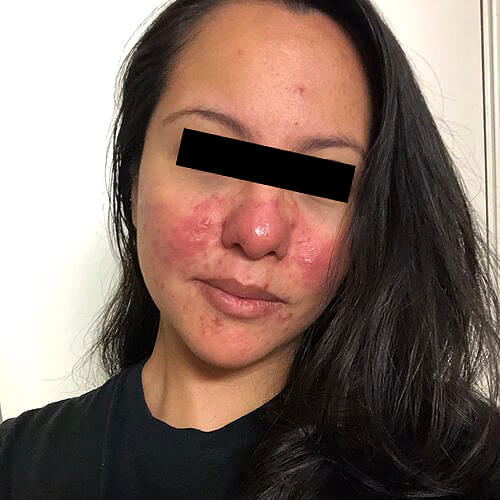 As a first step in a unique undertaking to boost rosacea research results by standardizing its study, a group of investigators including 63 experts from 17 countries as well as 25 rosacea patients have identified eight key aspects of the treatment or experience of rosacea, called core domains. Their use is expected to make it easier than ever for researchers, clinicians and pharmaceutical companies to amass meaningful information on how to better diagnose and treat this widespread disorder, according to a recent report in the journal JAMA Dermatology.1
As a first step in a unique undertaking to boost rosacea research results by standardizing its study, a group of investigators including 63 experts from 17 countries as well as 25 rosacea patients have identified eight key aspects of the treatment or experience of rosacea, called core domains. Their use is expected to make it easier than ever for researchers, clinicians and pharmaceutical companies to amass meaningful information on how to better diagnose and treat this widespread disorder, according to a recent report in the journal JAMA Dermatology.1
The rosacea core domain sets are being developed to create an opportunity to reliably compare research results from different studies, according to the article. While clinical investigations into rosacea have been steadily increasing, an important limitation in extracting significant data across these studies is the diversity in what is studied and how the different outcomes of therapies in those areas are measured.
“It’s often very difficult to combine the results because the studies have looked at varied types of potential outcomes,” said Dr. Murad Alam, professor of dermatology at Northwestern University Feinberg School of Medicine, who chaired the committee that authored the article. “But if researchers look at findings from the same group of parameters, the combined results would be comparable and far more powerful.”
The eight rosacea core domain sets identified include the following:
- The presence of ocular signs and symptoms (including blepharitis [dry eye] or corneal manifestations that threaten vision)
- Skin signs of disease, including nontransient erythema (persistent redness), telangiectasia (visible blood vessels), papules and pustules (bumps and pimples), edema (swelling) and phymatous (excess tissue) changes
- Skin symptoms of disease, including flushing/warmth and burning/stinging
- Overall severity of rosacea as rated by patients and physicians
- Patient satisfaction with treatment
- Quality of life
- Degree of improvement with treatment as rated by patients or raters around the time of peak effect
- Presence and severity of treatment-related adverse events lasting more than two weeks, including dermatitis (rash), discomfort, desquamation (peeling), erythema (redness), edema (swelling), granulomatous change (small bumps), worsening of rosacea
The article said that the standardized outcome measurements are intended for both researchers and clinicians, in practice as well as in clinical trials, and are not meant to be restrictive. Dr. Alam noted that investigators could still pursue their own research goals in addition to applying the standardized measurements as appropriate. Also, physicians in clinical practice could add the system to their routine patient care, to track patients’ response to various treatments, for example. While not mandatory, their use will be beneficial over the long run.
“You have to create the sense that it’s important to do for the greater good,” he said. “Why should physicians use a core outcome set? While it may not necessarily help their specific research project, in the long run, its adoption will help humanity.”
Rosacea is only one of many diseases under study for the development of core domain sets, an undertaking that has recently gained popularity and become more widespread, according to Dr. Alam. The difficulty in aggregating meaningful information from published studies was noted early on by the Cochrane collaboration group, a noncommercial organization that writes comprehensive review articles consolidating data from all published experimental work and clinical trials in an effort to provide high-quality evidence in support of health-care decisions, he said.
Solving this difficulty led to the development of core domain sets to standardize results. Moreover, rosacea is not the only disease being standardized; notably, there are a multitude of individual disorders under 34 broad categories of disease for which these sets are under development, according to a database of the undertaking maintained by the Core Outcome Measures in Effectiveness Trials (COMET) group in Liverpool, U.K. The searchable database notes the existence and progress of studies in the various categories.
The process of developing these standard sets for rosacea was elaborate and lengthy, according to the article. Two researchers first created a long list of possible outcomes gleaned from studies published between 2010 and 2020 in the English language that both assessed an outcome of an intervention for rosacea and had at least 10 human subjects. They also added outcomes identified in patient interviews and other published sources. A committee of four dermatologists then refined the long list by eliminating duplicates and consolidating similar outcomes, and the eight key domain elements emerged after two rounds of surveys and three consensus meetings.
The final step in developing core domain sets for rosacea is to identify one measure – a scale or score, for example – for each domain, Dr. Alam said. “The perfect is the enemy of the good,” he said, noting that rather than developing a new, more ideal measure over a long period, many are opting to select from existing measures that may be implemented more readily. For rosacea, this final step of identifying one measure for each domain is probably a couple of years away.
“The new core outcome systems are all-encompassing, across disciplines and around the globe,” he said. “It’s the best of both worlds – researchers know that while adding to the total sum of knowledge, the power of their individual studies will be magnified.”
Reference:
1. Dirr MA, Ahmed A, Schlessinger DI, et al. Rosacea core domain set for clinical trials and practice: a consensus statement. JAMA Dermatol doi:10.1001/jamadermatol.2024.0636. Published online April 24, 2024.